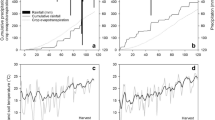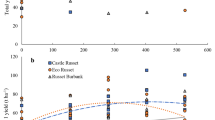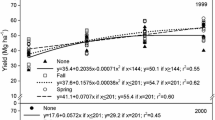Abstract
Irrigation, nitrogen and gypsum were investigated in a 3-year study to determine their influence on specific gravity and internal physiological defects. Excess irrigation during August and September reduced specific gravity, increased the incidence of hollow heart, and in some years, internal brown spot. Tuber yields were not significantly affected by excess irrigation. Exclusion of late season irrigation, however, significantly reduced tuber yields.
No consistent yield response to nitrogen was evident, but a response up to 168 kg/ha was observed in 1987. Nitrogen rate did not effect hollow heart, internal brown spot or chip color.
The incidence of internal brown spot in the tubers of check treatments was quite variable from year to year, and ranged from 8 to 21%. The lowest incidence of internal brown spot observed in 1989 coincided with the highest calcium levels in the tuber peel. Although gypsum treated potatoes had reduced incidence of internal brown spot, the effects were partial and inconsistent. Significant increases in peel and petiole calcium concentrations in the gypsum treated plots only occurred in one year. The peel calcium levels appeared to be influenced more by the season and to a lesser extent by gypsum. Gypsum applications produced no effects on total or US#1 tuber yield, specific gravity, hollow heart, or chip color. Preliminary data also suggested that gypsum did not markedly influence the incidence of blackspot. Based on this study, a routine gypsum application to improve the tuber quality of the variety Atlantic is not recommended.
Compendio
Se investigaron la irrigación, el nitrógeno y el sulfato hidratado de calcio en un estudio de tres años, para determinar su influencia sobre la gravedad especifica y los defectos fisiológicos internos. El exceso de irrigación durante agosto y setiembre redujo la gravedad específica, incrementó la incidencia de corazón vacío, y en algunos años la de la mancha parda interna. Los rendimientos en tubérculos no fueron afectados significativamente por el exceso de irrigación. Sin embargo, la eliminación de la irrigación al final de la temporada redujo significativamente los rendimientos en tubérculos.
No hubo una respuesta consistente evidente del rendimiento al nitrógeno, pero en 1987 se observó una respuesta de hasta 168 kg/ha. La tasa de nitrógeno no afectó el corazón vacío, la mancha parda interna o el color de las papas fritas a la inglesa.
La incidencia de la mancha parda interna en los tubérculos de las tratamientos testigo varió mucho de año a año, de 8 a 21%. La incidencia más baja de mancha parda interna observada en 1989, coincidió con los niveles más altos de calcio en la cáscara del tuérculo. Aunque las papas tratadas con el sulfato hidratado de calcio tuvieron una incidencia reducida de mancha parda interna, los efectos fueron partiales e inconsistentes. Incrementos significativos en las concentraciones de calcio de la cáscara y el peciolo en las parcelas tratadas con sulfato hidratado de calcio se presentaron solamente en un año. Los niveles de calcio en la cáscara estuvieron posiblemente influenciados mayormente por la temporada y en menor grado por el sulfato hidratado de calcio. Las aplicaciones de sulfato hidratato de calcio no afectaron el rendimiento total de tubérculos ni el de tubérculos US#1; tampoco la gravedad específica, el corazón vacío o el color de las papas fritas a la inglesa. La información preliminar sugiere también que el sulfato hidratado de calcio no influye marcadamente sobre la incidencia de la mancha negra. Basándose en este estudio, una aplicación rutinaria de sulfato hidratado de calcio para mejorar la calidad del tubérculo de la variedad Atlantic, no es recomendable.
Similar content being viewed by others
Literature Cited
Anderson, J.W. 1968. Extraction of enzymes and subcellular organelles from plant tissues. Phytochemistry 7:1973–1988.
Chase, R.W. and G.H. Silva. 1987. Potato bruising. Michigan State Univ Coop Ext Bull E-2074.
Collier, G.E, D.C.E. Wurr and V.C. Huntington. 1980. The susceptibility of potato varieties to internal rust spot. J Agr Sci Cambridge 91:241–243.
Dinkel, D.H. 1960. A study of factors influencing the development of hollow heart in Irish Cobbler potatoes (Solanum tuberosum L.). Ph.D. Thesis Univ of Minnesota. 81 pp.
Ellison, J.H. and W.C. Jacob. 1952. Internal browning of potatoes as affected by date of planting and storage. Am Potato J 29:241–252.
Harris, P.M. 1978. The potato crop: The scientific basis for improvement. Chapman and Hall press, London.
Henninger, M.R. and R. Webb. 1979. Tuber necrosis in “Atlantic.” Am Potato J 56:464.
Hiller, L.K. and D.C. Koller. 1982. Brown center and hollow heart as a quality factor. Proc Washington State Potato Conf. 21:101–108.
Hooker, W.J. (Ed.) 1981. Compendium of potato diseases The American Phytopathological Society, St. Paul, MN. 125 p.
Irritani, W.M. and L. Weller. 1973. Dry matter content of apical and basal portions of Russet Burbank potatoes. Am Potato J 50:389–397.
Irritani, W.M., L.D. Weller and N.R. Knowles. 1984. Factors influencing incidence of internal brown spot in Russet Burbank potatoes. Am Potato J 61:335–343.
Kratzke, M.G. and J.P. Palta. 1985. Evidence for the existence of functional roots on potato tubers and stolon: significance in water transport to the tuber. Am Potato J 62:227–236.
Kelly, W.C. and J.A. Christianson. 1970. Internal necrosis of potato tubers — calcium deficiency. HortScience 5:309 (Abstract).
Marra, M.C., A.S. Kezis, S.M. Goltz, W.E. Hedstrom and R.D. Hews. 1987. The economic implications of potato response to irrigation: Results from 1985 field tests in Maine. Am Potato J 64:249–260.
Michigan Potato Research Report. 1986. Vol. 18. Michigan State University, E. Lansing, MI.
Millar, D.E. and M.W. Martin. 1987. Effect of declining or interrupted irrigation on yield and quality of three potato cultivars grown on sandy soil. Am Potato J 64:109–117.
McGuire, R.G. and A. Kelman. 1984. Reduced severity of Erwinia soft rot in potato tubers with increased calcium content. Phytopathology 74:1250–1256.
Moore, H.C. 1926. Hollow heart of potatoes. A defect often found in some seasons which may be reduced by proper cultural methods. Michigan Quart Bull 8:114–118.
Moore, H.C. and E.J. Wheeler. 1928. Further studies of potato hollow heart. Mich Quart Bull 9:137–139.
Murphy, H.J. and M.J. Goven. 1959. Factors affecting the specific gravity of the white potato in Maine. Maine Agri Exp Sta Bull 583.
Ojala, J.C., J.C. Stark and G.E. Kleinkopf. 1990. Influence of irrigation and nitrogen management on potato yield and quality. Am Potato J 67:29–43.
Painter, C.J. and J. Augustine. 1976. The effect of soil moisture and nitrogen on yield and quality of Russet Burbank potatoes. Am Potato J 53:275–284.
Rex, B.L. and G. Mazza. 1989. Cause, control and detection of hollow heart in potatoes: A review. Am Potato J 66:165–183.
Rich, A. 1983. Potato diseases. Academic Press, New York, NY. 238 p.
Sanders, D.C., R.E. Nylund, E.C. Quisumbing and K.V. P. Shetty. 1972. The influence of mist irrigation on the potato: IV. Tuber quality factors. Am Potato J 49:243–254.
Simmons, K.E. and K.A. Kelling. 1987. Potato response to calcium application on several soil types. Am Potato J 64:119–136.
Simon, E.W. 1978. The symptoms of calcium deficiency in plants. New phytologist. 80:1–15.
Smith, O. 1976. Potatoes: Production, Storing, Processing. Avi Pub Co Connecticut USA.
Tzeng, K.C., A. Kelman, K.E. Simmons and K.A. Kelling. 1986. Relationships of calcium nutrition to internal brown spot of potato tubers and sub apical necrosis of sprouts. Am Potato J 63:87–97.
Vitosh, M.L. 1984. Irrigation scheduling for potatoes in Michigan. Am Potato J 61:205–213.
Vitosh, M.L. 1990. Potato fertilizer recommendations. Michigan State Univ Coop Ext Bull E-2220.
Wolcott, A.R. and N.K. Ellis. 1959. Internal browning of potato tubers: Varietal susceptibility as related to weather and cultural practices. Am Potato J 36:394–403.
Author information
Authors and Affiliations
Additional information
Journal article No. 000116. This research was supported by a USDA-AES special grant 85-CRSR-2-2562.
Mention of a trademark does not constitute an approval of the product or exclusion of other products that may be suitable.
Rights and permissions
About this article
Cite this article
Silva, G.H., Chase, R.W., Hammerschmidt, R. et al. Irrigation, nitrogen and gypsum effects on specific gravity and internal defects of Atlantic potatoes. American Potato Journal 68, 751–765 (1991). https://doi.org/10.1007/BF02853806
Accepted:
Issue Date:
DOI: https://doi.org/10.1007/BF02853806




